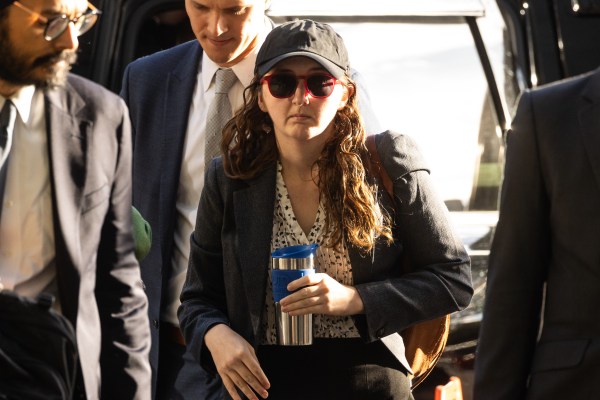Caroline Ellison’s testimony at Sam Bankman-Fried’s trial spread into a second day, digging deep into the state of crypto trading firm Alameda Research’s faulty balance sheets.
“We were in a bad situation,” Ellison said, referring to the time period between May and June 2022. “[We were] concerned if anyone found out it would all come crashing down.”
At the time, Terra/LUNA collapsed, causing a number of crypto market players to struggle and cryptocurrencies to lose value. The stablecoin’s implosion came months before FTX itself collapsed, an event that was triggered when a balance sheet was leaked by CoinDesk that cast doubt on its solvency. Ellison testified that the balance sheet was one shared with lenders, not the accurate one the company used internally. This means that the balance sheet CoinDesk reported on was also “dishonest” and still “understated true risk” of Alameda and FTX.
Ellison testified that Alameda had to repay crypto lenders like Genesis, who were asking for loans to be repaid. She said FTX customer deposits were used to repay lenders, and when lenders requested balance sheets in mid-June 2022, FTX modified them because “Alameda was in a very bad situation” and didn’t want “[Genesis] to know that.”
But instead of sending truthful balance sheets, showing how much money Alameda “borrowed” from FTX, they modified it to “make [its] leverage and risk look lower.” This was done at the direction of Bankman-Fried, Ellison said.
She added that this was done for several reasons, one of which was that Alameda didn’t want Genesis to recall all of Alameda’s loans or for the news to spread because it would add concern about the firm.
“I didn’t want to be dishonest but also didn’t want to tell the truth,” Ellison said on the stand.
So she prepared seven balance sheets for Bankman-Fried to review with “alternative ways” of presenting their financial situation to “conceal things” that they “both thought were bad.” These balance sheets were made “to look better to lenders,” Bankman-Fried said at the time, according to Ellison.
At the time in June 2022, Alameda borrowed $9.9 billion from FTX customers, which “made it clear Alameda was in a risky situation,” Ellison said, and would make FTX “look very bad.” It also had open term loans worth $1.8 billion that would have to be paid back at any time a lender reached out to ask for the money back, as well as $2.9 billion in fixed term loans that were “long-term liabilities,” Ellison said.
The company at the time had around $12 billion in liabilities and $3 liquid billion in assets, per Ellison.
In the courtroom, Bankman-Fried’s mother rubbed her eyes, removing her glasses and staring at her son with a fist over her mouth, then back at the monitor showing the government’s evidence of the balance sheet.
Of the seven balance sheets, the leaders chose the last one, number seven, to show lenders because it was “safer,” Ellison said. There was no note of the FTX “borrow” or related loans, which were broken down and put into “long-term” liability categories to make it look better, Ellison said.
The term “borrow” is used loosely and as a tactic to not have in writing that FTX was taking customer deposits for Alameda’s benefit, Ellison also said. Bankman-Fried did not want it in writing, she added.
A widening gap sat between what Bankman-Fried said and what was happening on the ground. Despite tweeting on June 27, 2022, that “backstopping customer assets should always be a priority,” the missive was sent after Alameda took billions of customer assets to repay lenders. Per Ellison, the barrage of bilge continued in later updates to lenders and others.
By September of 2022, the FTX “borrow” line item had swelled to $13.7 billion due to some repaid loans and other investments. The figure eventually got as high as $14 billion or $15 billion by October of the same year, Ellison testified. At that point, the company was frantic to find more capital to right its ship — potentially selling shares to investors or even to the Saudi crown prince.
Ellison, who took a plea deal to lower her possible criminal liability in exchange for cooperation, is a blockbuster witness in the trial of Bankman-Fried. The former CEO has pleaded not guilty and is contesting the charges against him.
A lingering impact
The collapse and bankruptcy of FTX was partially responsible for the present-day crypto downturn, which has seen venture investment as well as consumer interest in web3 technologies and products moderate. FTX, a poster child for crypto’s ascent in the 2021–2022 era, became one of its highest-profile failures.
Its failure not only burned a number of high-profile venture capitalists, but it also caused retail investors to lose capital or have their funds frozen. The fallout from the failure of FTX spread further than just its investors and customers, however. A host of crypto-focused companies failed in the wake of FTX’s own demise: BlockFi, Celsius, Three Arrows Capital and Voyager.
BlockFi was in trouble with the SEC before FTX flirted with buying the company, and it eventually filed for bankruptcy. Celsius has since been hit with suits from the SEC, the Commodity Futures Trading Commission and the FTC. Three Arrows Capital founder Su Zhu was later arrested in Singapore and sentenced to four months in prison. Binance’s U.S. arm eventually passed on buying Voyager, which has also been the target of lawsuits.
The final legal chapters for crypto’s most recent golden age are not yet written, but they are being scribbled down before our eyes. Their combined damage to crypto projects, work and its in-market viability remain to be fully accounted for.
Ellison testified part of Tuesday afternoon into all day Wednesday and is expected back on the stand Thursday. “I felt indescribably bad about people who lost money, jobs [and] people we betrayed,” Ellison said, tearing up and wiping her nose with a tissue.
